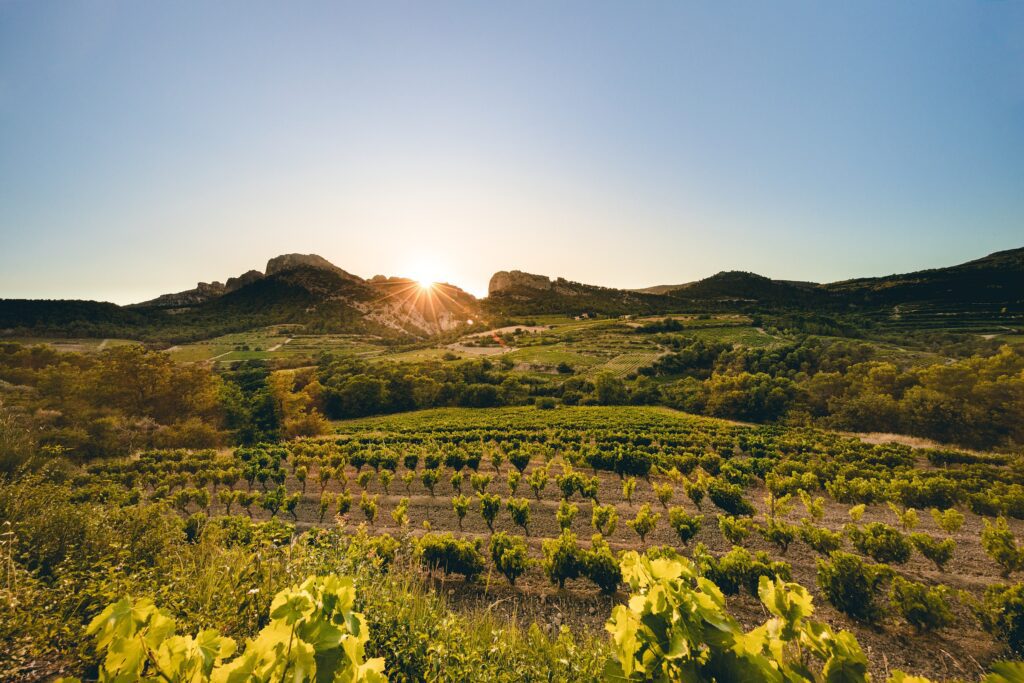Two Rhône Valley winemakers offer their exclusive perspectives on sustainable production in the region and its implications for winemakers.
The most recent Entre Rhône tasting in London allowed attendees to see first-hand the enormous diversity of the Côtes du Rhône and its associated rocks. With over 85 wines to choose from, including red, white, rosé and sweet wines from a number of appellations, it served as a reminder to the UK wine trade of the diversity on offer from the southern France region.
Two of the winemakers in attendance also showed off the versatility. Representing the Rhône's established wine industry and a new generation to come, they reflect the Rhône's current efforts towards sustainability and the forces driving them forward.
Maurice Gauci, owner of Chateau Boccaro alongside his wife Saskia, is a new voice in the Rhone. After moving from Luxembourg in 2017, they started making wine in 2019.
For him, the question of organic production had already been decided by the time they bought the property. After seeing that organic wine was “no longer seen as geeky,” he knew the property had organic potential.
Furthermore, since viticulture is an integral part of the local community, it makes sense to protect their homes and the surrounding areas. “We lived in the middle of our own vineyards, so I thought it made sense to keep the environment right for us and our family,” he explains.
Claude Chabran, on the other hand, offers a more historical perspective on the progress of sustainability in the Rhone Valley. As President of the Rhonéa Group, he is at the heart of the industry, after 25 years working in the region. The road to full sustainability has not been smooth.
“I think the real change happened from 2010 to 2015, maybe,” he says. “But the market wasn’t there at that time, so a lot of producers went back to traditional viticulture around 2016. Now, there’s a new trend toward organic over the last four or five years.”
It is a trend that now represents a large portion of the Rhone's production. In 2022, 28% of the Rhône Valley's vineyard area received HVE certification, a label of high environmental value. Another 20% was grown organically.
According to Shabran, it represents a generational change. “We have a new generation that is more aware of the problems with chemicals, the problems of intensive viticulture, and they want to go back to tradition.”
He admits, however, that the region's winegrowers are in a privileged position. “It is, in my opinion, the ideal location for organic viticulture,” he admits, highlighting the free-draining soil and australian wind.
Gucci agrees that change occurs across generations and is the result of technological progress. It is also assumed to be a new frontier. “Sometimes it also poses a challenge for the winemaker,” he says. “He runs the floor and wants to go further.”
If this is sometimes a challenge – Gucci admits that finding the right people is a more intensive process – it is vindicated in the Rhône Valley proposition for both visitors and drinkers.
With the growing popularity of botanical tourism and sustainable viticulture, the well-preserved landscape attracts visitors and drinkers. Although landscapes are now treated with more emphasis, such as through the Vignobles Découvertes programme, interest in landscapes has been in place long before these became trends.
If we take the Beaumes de Venise appellation as an example, it has always given priority to landscape. Chapran, who has worked with the appellation for decades, recalls excluding timber from the appellation's boundaries at its inception 18 years ago. These areas have been deliberately neglected to discourage development and preserve the natural landscape.
The diversity of appellations and the large number of vine growers continue to ensure the protection of the landscape. As Gucci summarizes, “The first person to protect a piece of land is the owner. If we have 7,000 owners, we have 7,000 people who will do everything they can to protect and preserve the land.
As the Côte du Rhone and associated territories adapt to changing consumer demands, connecting with the landscape will be key. Current projects, for example expanding white wine production to 300,000 hectoliters by 2031, will be strengthened through ecotourism and a better understanding of the green credentials of the Rhone Valley.
For Gucci, the challenges are great, but the opportunities are also great. After all, as he highlights, the Rhone Valley is the closest Mediterranean wine region to the UK, making it a logical choice for affordable, popular styles. Maintaining a balance between value, sustainability and style is difficult, but it can offer rewards.
However, his choice to make wine there also has simpler reasons. “By being involved in agriculture, I have a greater chance of preserving biodiversity. Seeing biodiversity makes me happy, and when I feel happy I work better.”


